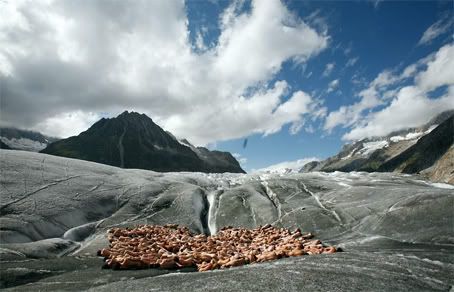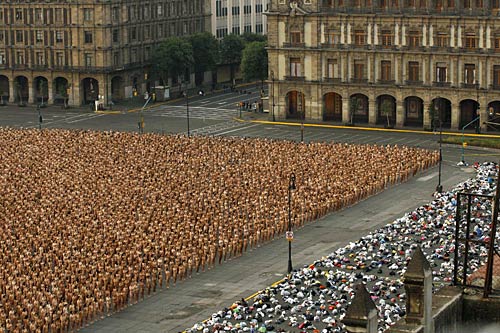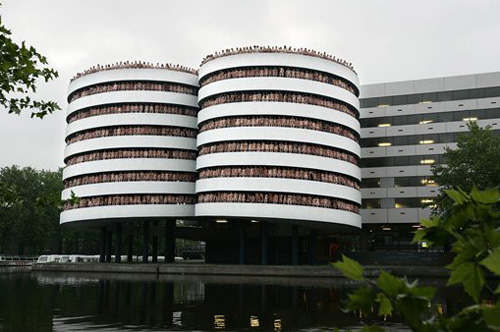Στο Άμστερνταμ φωτογραφήθηκα γυμνός και εγώ.
Απλά τον εκτιμώ.
| SPENCER TUNICK 'BODY SCULPTURES' |
From 1992 onwards, Spencer Tunick photographs increasing numbers of nude people, initially in New York, but soon also in diverse urban settings in the Americas, Europe and Australia. These 'nude happenings' have been widely commented in the media. Nudes in the city, and in such huge numbers at that: that certainly cannot go unnoticed...
No doubt, Spencer Tunick pushes the boundaries. Ever since it developed in the second half of the nineteenth century in remote places, nudism knew to conquer the more accessible beaches from the sixties onwards, where there is no longer any serious resistance against increasing degrees of nudity - at least in the Western World. Things are different when it comes to public places in an urban context, where men spends his productive time. There, clothes remain obligatory, even when the temperature raises to intolerable levels - and that is why the city has become the stage for all kinds of new forms of exhibitionism (see "Uncovered' by Jordan Matter). As soon as lingerie saw the light of day, many a human creature discovered the thrill of wearing it underneath working apparel or, conversely, of being naked underneath clothes. Others enjoy denudating themselves or making loving in places where they can be watched without being easily disturbed, as before the windows of their appartment, alongside roads or in fast moving cars. A particular variant is the fad of 'streaking', which became increasingly popular in the seventies in places where there are lots of people, like on campuses, parks or hotels, preferably when there are also cameras around, as with sport manifestations. Figures like Mark Roberts specialised on streaking during sport events and became world famous. Equally world famous became Spencer Tunick with still another variant: 'mass streaking' on an up to now unprecedented scale.
TRANSGRESSION?
All eyes can see 'how a country can be free and treat the naked body as art. Not as pornography or as a crime, but with happiness and caring.”
Spencer Tunick
The increase in scale has not the effect one might expect. To begin with, it bereaves the undertaking of one of its most important charms: the effect of surprise. It is impossible to summon up hundreds or thousands of people without making agreements about where and when, and these cannot possibly be kept secret. With, as a further consequence, that the authorities are not only to be informed, but have to lend their cooperation as well, especially since there are photos to be made, which requires the necessary preparatory logistics. Spencer Tunick has been warned: initially, when he still worked on a modest scale, he repeatedly had collisions with the authorities and even had to spend some time in jail. But things are different when we are dealing with a mass event: the degree of transgression diminishes when the number of participants increases. It is not difficult to scorn an individual for some 'perversion', but that is no longer possible when hundreds or thousands indulge in the forbidden pleasures. It suffices to compare with nudism or naturism: when everybody is naked, the nude is bereft of all its titillating allure. Not unjustifiably do many participants - wholly in tune with nudists - declare that they are surprised about the naturalness with which they experience their nude status in such a huge crowd. Which only betrays that their real expectations were opposite. No wonder that many a participant in Spencer Tunick's projects retains the sweetest remembrances of his participation - the feeling of reassuring normalcy inclusive. The ambivalence of such mitigated - if not neutralised - transgression is eloquently contained in a phrasing of a participant to the project in Bruges: 'Spencer Tunick is liberating mankind of its self-imposed prison of clothes'.
But such rather transparent ambivalence is only to be heard off-stage. In the official discourse, the erotic component of the original streaking is empathically denied. Thus, BBC News quotes University lecturer Fiona Jamieson from Newcastle: 'The photos are of nude people, but there is nothing sexual about it.' And, on occasion of an interview of Spencer Tunick, 'The Telegraph' declares: 'Spencer Tunick's studio walls are plastered with his photographs of naked people, but there is none of the jaunty, dirty feel of the girly calendar you might find on a car mechanic's wall'. And in the already mentioned BBC News, Spencer Tunick himself declares: 'There is a sensual element to it, but it's not a sexual experience.' The emphasis with which it is denied that there possibly could be an erotic component, cannot but remind again of the statements with the same intention, of which the literature of nudists and naturist brims over.
BODY SCULPTURE
"I just create shapes and forms with human bodies.
It's an abstraction, it's a performance, it's an installation".
Spencer Tunick
The neutralising move is only completed in that Spencer Tunick proceeds to sell his already neutralised form of streaking as... a form of art! Often, it is museums or galleries (among them Saatchi & Saatchi) which take the initiative. Spencer Tunick likes also to pose as a photographer. No doubt, the taking of photographs is an essential part of Spencer Tunick's undertaking, were it alone for the fact that only thus can the event be witnessed by a much larger public. But, even though the C-prints are sold for a cool 4.500 Euro, that does not prevent them from being only interesting from a mere documentary point of view, not as artistic photos. We are dealing here with mere instrumental mimesis, not otherwise than is the case with most photos of happenings or land art. That is probably why others focus on the event rather than on the document. And here also, they borrow their terminology from the realm of art: there is talk of 'installations' or of 'nude-happenings'. And, because these phenomena have only a peripheral status in the world of art, still others prefer to speak of 'Body sculptures': sculptures made with bodies instead of marble or bronze. In the same vein, Spencer Tunick inscribes himself in the tradition of 'land art': just like land art transforms a natural environment through natural materials, just so is an urban environment transformed through the use of naked bodies... In the same breath, naked bodies in an urban environment are reduced to mere neutral materials in the hands of an 'urban artist'...
The disguise as art is not just a pretext. In Düsseldorf, Spencer Tunick had a 'body sculpture' piled up in front of Rubens' 'Venus and Adonis', and on the Piazza Navona in Rome, the mass of bodies is emphatically photographed against the background of the sculptures of the fountains. The gesture is not new. During the summer of 2006, Jan Fabre had the attributes and video-tapes of his poor performance with Marina Abramowich exhibited in the prestigious Rubens Hall in the Museum of Fine Arts in Antwerp, as if we were dealing here with comparable items, let alone comparable quality...
Let us therefore phrase it unambiguously: Spencer Tunick's performances have nothing to do with art. There is never talk of mimesis, but always of displayed reality - in case: bodies that are staged like otherwise on a catwalk, although with Spencer Tunick, they wear no clothes. And that Spencer Tunick's bodies are arranged in larger compositions, does not alter their status as real things: also flowers in a vase are displayed reality, and they are not transformed into art in that they are arranged. Besides, Spencer Tunick's arrangements are not precisely interesting. Masses are either randomly distributed like spontaneous masses in streets or on squares, or they are organised in rather elementary patterns, like those of Nero in the Coliseum or those of Hitler's military parades on the Zeppelinfeld. In the majority of his 'installations' - and hence also in his photos - Spencer Tunick relies on similar, rather poor compositions. There are only few attempts to proceed to more sophisticated arrangements, as when he aligns his bodies to environmental formations, like in Black Rock Desert (Nevada 2000) or in Spence Hot Springs (New Mexico 2001). But precisely then, the lack of compository sophistication only catches the eye in comparison with what great artists like Rubens knew to realise - would Spencer Tunick have the guts to pile up his bodies in front of the 'Fall of the Angels' in the Alte Pinakothek in Munich (see picture above this article)? Granted, it would turn out to be rather impossible to realise compositions like those of Rubens in the real world with real bodies. But is that not precisely the reason why mimesis is superior to reality?
That Spencer Tunick nevertheless succeeds in selling his projects as art, can only be understood when we remind of the fact that the art world itself has opened the doors wide for all kinds of related, but nevertheless totally different activities. More precisely in matters of streaking, the trend was set with the introduction of the happenings in the sixties. These provided the incrowd, that meets in galleries on occasion of vernissages and finissages, with more appropriate entertainment than the artworks, that, after all, are merely hanging there on the walls. In those galleries, the happening developed into all kinds of 'performances'. The galleries themselves were thereby transformed into stages for primitive forms of theatre, if not for the real world as such. Such metamorphosis was all the more charming since it could pass for a revolution in the plastic arts: the so-called 'transition from art to life'. In that, under the guise of art, many things are allowed that are forbidden in the real world, it was obvious to endorse such formal revolution with a moral revolution - especially since the number of visitors only increased in accordance with the degree of transgression - say with the introduction of some sadism or eroticism (Nitsch, Schwarzkogler...).
NEITHER ART NOR TRANSGRESSION
And that cannot but remind us of the fact that it is not only the nature of art that is denied here, but in the first place the nature of the undertaking that is posing as art. For, it is not only the emphatically denials of the 'sexual nature' of Spencer Tunick's installations that neutralise the in essence transgressive nature of streaking. Also nudity itself is neutralised in that it is reduced to a mere element in an abstract composition. In that respect, it speaks volumes that a visit to the official website of Spencer Tunick confronts you, not with the nude in public urban space, but with the invitation of indicating the tint of your skin on the palette of colours that Spencer Tunick will soon use to make his next 'body sculptures'...
Notwithstanding, we cannot but harbour the necessary sympathy for this new form of mass entertainment: I prefer to see a stream of nudes in the city than a holy procession of flagellants. I welcome the rays of the sun, even when they come to us through the veil of an artistic mist. And even that mist is not to be scorned. That it is disguised as art, made it possible that meanwhile thousands and thousands of mortals, who perhaps wanted, but did not dare to break through the daily drudge by proceeding to the transgressive act of streaking, could indulge en masse in these forbidden pleasures with the good conscience of having taken their part in a new revolution in art - if not of having become living sculptures themselves, and being thus immortalised by a world-famous artist on a photo signed by the master himself as a reward and a proof of their participation in the revolution and their metamorphosis into artworks.
That is why we willingly - although with some tongue in cheek - join the call in The Times Online: 'Do you have naked ambition? Then bare it and become a living artwork. Go starkers for culture'...














Δεν υπάρχουν σχόλια:
Δημοσίευση σχολίου